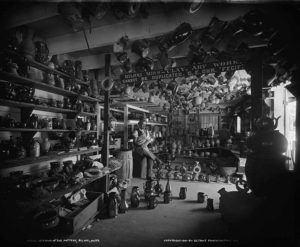By Sam Ben-Meir, Ph.D

NEW YORK — What are the aesthetic, sensuous, and expressive possibilities inherent in clay as a material substance in all its physicality? How is it possible that ceramics can restore, or rather reconfigure and remake our relationship to the natural world? These are among the fundamental questions posed by “Shapes from Out of Nowhere: Ceramics” from the Robert A. Ellison Jr. Collection — an exhibition running at the Metropolitan Museum of Art through August 29.
Perhaps on an even more basic level this exhibition challenges us to ask the question: What is the significance of shape in and of itself? As George E. Ohr, the grandfather of modern ceramics observed, “Shapes come to the Potter as verses come to the poet.”
Ellison was an abstract expressionist painter, who, having come to New York City from west Texas in 1962, was as he said “unable to find traction” as a painter. At the same time, he began collecting ceramic objects and educating himself about this field of art as he went along. In 2009 he bestowed on the Metropolitan Museum of Art over 300 extraordinary examples of American ceramics, spanning the years 1876 through 1956. Since then, Ellison has gifted to the museum over 600 works — including a significant collection of European art pottery in 2013, and most recently over 125 modern and contemporary clay vessels and objects — making the museum one of the most significant repositories of art pottery in the world.

The current exhibition presents nearly 80 pieces drawn from Ellison’s latest donation, and it is a thoroughly captivating show; even where (or perhaps especially where) the works are outlandish, bizarre, sometimes almost monstrous, but nonetheless enthralling. Some of the greatest ceramic artists of the last century are represented here — including Ohr, the “Mad Potter of Biloxi,” a visionary who was perhaps the first to experiment with ceramic abstraction but went largely forgotten after his death in 1918, until his rediscovery by an antiques dealer in the 1970s; and Peter Voulkos, another pioneer who was influential in the shift away from functional or utilitarian ceramics (he would tell his students at University of California, Berkeley to make a teapot “only if it didn’t work”). Voulkos, along with Kenneth Price and John Mason (also featured in the exhibition) together developed what has come to be known as Abstract Expressionist Ceramics.
Visitors to the exhibition will find themselves greeted by Axel Salto’s Vase (1945), a mesmerizing piece — large, green, and irregularly shaped — done in the artist’s so-called “budding style,” which took its direction from the forms of naturally growing plants. It is a fitting way to commence an exhibition that essentially charts the movement from representational to abstract ceramic art, from functional pottery to purely aesthetic clay objects that have taken a decisive step closer to sculpture.
It is a development that can hardly be underestimated when we examine it from a theoretical-historical standpoint — inasmuch as the non-representational, non-instrumental ceramic work elicits from us a very different response than a utilitarian object, that is, an object the telos of which is already fixed, defined, and ultimately external to the work.
Consider for a moment the ancient Athenian water-vessels (hydriai) which did, of course, possess a certain utility value — namely, to carry water. But part of what makes these Grecian jars so remarkable is that looking at them we get the impression that “the water created for itself the only envelope that would exactly fit it,” as the great theoretical biologist Jacob von Uexküll observed. In other words, it is almost as if the water somehow discovered the ideal covering or “clothing” for itself, and only then was this form made use of by human beings. Which is to say, the utility or instrumental value of these ancient ceramics — their relevance to our own ends — is of less importance than, and ultimately superseded by the demands of the object itself, or if you prefer, by its own inherent telos.
The Austrian-born American, Otto Natzler, is among the most notable ceramists featured in this exhibition. He worked closely with his second wife Gertrud Natzler — influenced in part by the Vienna Secessionists, they produced some of “the finest pottery of all time,” observed ceramic art consultant Dane Cloutier, writing for Modernism Magazine (1999). The piece included here, “Circular Open Disk Form” (1984-85), was made after Gertrud passed away in 1971. A deceptively simple piece painted in a monochromatic brown, it is in fact an elegant and graceful lesson in the subtleties of texture, color, and form.
Anne Marie Laureys’ work is among some of the most shockingly beautiful to be featured in this remarkable exhibition. It possesses a look and a feel entirely its own, unlike anything else; even as she is clearly influenced by the groundbreaking genius of Ohr, who boldly extended the ceramist’s vocabulary in ways that were unprecedented, drawing on modes of manipulation that remained hitherto unexplored — including pinching, folding, crumpling, and collapsing, as well as puncturing, ruffling, twisting, and tubing. Laureys’ “Cloud Unicus” (2017) has — like so much of her work — an otherworldliness, a transcendent organicism, that is at once living, vulnerable, immeasurably exquisite, and yet seemingly ephemeral, and transient — as though to breathe too hard upon it would send the thing drifting and dissolving like a billow of smoke.
Laureys learned from Ohr that what gets thrown on the wheel is not necessarily the finished work but may be only the beginning of the process. In “Cloud Unicus,” three distinct volumes have been separately thrown and masterfully conjoined. Her work is profoundly sensuous and demonstrates that the textures one can elicit from clay are practically infinite — in Laureys’ hand the material becomes as soft as velvet, as gently ridged as the ripples of a barely ruffled pond. By eschewing glaze and throwing incredibly thin — at the point where the material is just on the verge of losing its form — Laureys preserves the traces of her process, whereas ceramists typically efface them. This allows the viewer the chance to enter imaginatively into the space where these works came into being, creating a relationship to the work that is intimate, embodied, and unpredictable.
The title of Amara Geffen’s “Potemata” (1991) is immediately suggestive of power — which is entirely appropriate in the context of this astounding, almost oracular form. Both color and texture mimic the effects of centuries of oxidation, neglect and erosion — which strengthens the sense that we are before some kind of ancient artifact of almost sibylline significance and potency. The piece derives much of its power from the immensity of that unimpeachable refinement and poise which permeates this particular form — from the confidence of its broad, rounded shoulders which symmetrically stretch out into two expansive wings, both of which come to a point before tapering down to a narrow, curvilinear base.
It is hardly surprising, given his extraordinary innovation, that Ohr was dismissed in his day as grotesque, as lacking in taste and training, whereas today he is now regarded as a master of “delicacy and restraint,” employing a rich repertoire of motifs and textures, including strange and idiosyncratic glazes that are among the most beautiful ever crafted. This exhibition offers a small but tantalizing handful of his pieces, serving to illustrate some of his extraordinary techniques — such as Vase (1898-1910), thrown impossibly thin yet twisting upon itself and somehow blossoming with dual spouts like a weird and wonderful flower. There is also Vase (1897-1900), an all-black, glazed form that began as a wheel thrown pot; Ohr then expertly folded this simple vessel utilizing one of his signature techniques. In the process the mouth is elongated, curving upward from the foot to where it finally reaches the uppermost lip; circumscribing a cavity that is at once sensuous, dark and enigmatic.
The utter opposition of Ohr’s output to the factory-made ceramics of the northern industrialists undoubtedly carried a social significance for this politically radical artist, who was we know a supporter of socialism and the rights of “the common man.” This is worth bearing in mind when we consider that there is something inherently subversive in the aesthetic movement that involves transcending functionality and utility — inasmuch as the viewer has now to step outside the realm of the familiar, the realm of what is comfortable, easy and known. Instead, the viewer is being challenged to construct new ways of being and new modes of sensibility and sensuous participation, the ultimate outcome of which cannot be mapped out in advance. We are being thrown, as it were, into a new world — at times a more complex and distorted one, but also one that has the potential for modes of intimacy and becoming which could prove transformative in ways that we may not otherwise have known.
*
Sam Ben-Meir is a professor of philosophy and world religions at Mercy College in New York City.